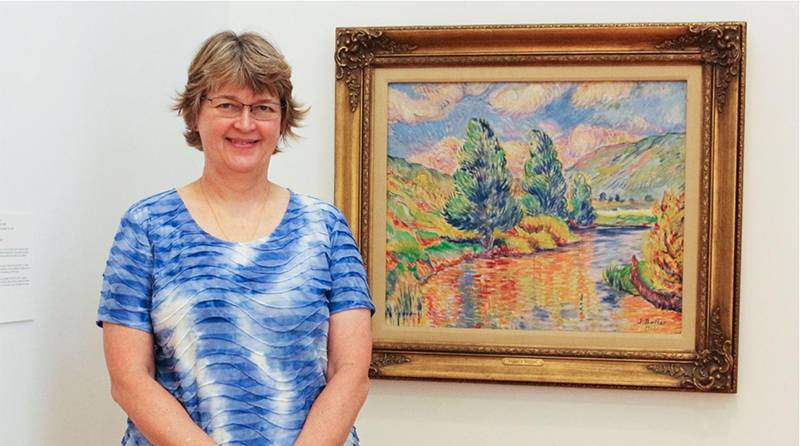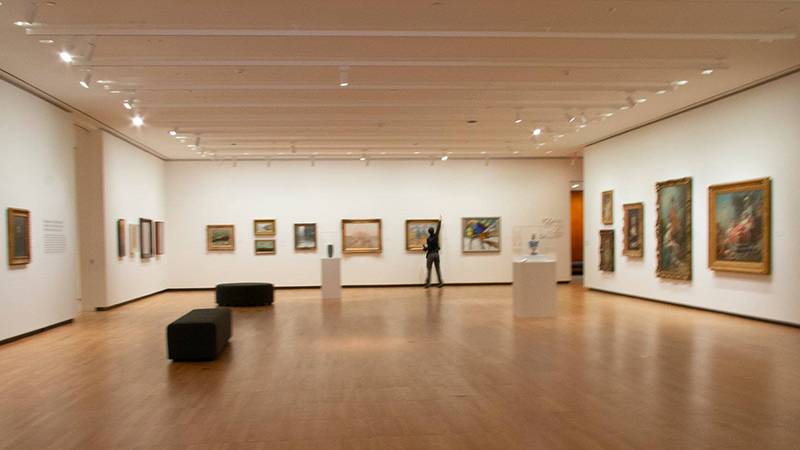I recently visited Krannert Art Museum to see the new exhibition “Renaissance to Modern Remix: Highlights from the European and American Art Collection.” That day the museum itself was suspiciously empty, but I didn’t mind. I enjoyed the peace and quiet and the opportunity to talk with the museum docents. They were really friendly; and, a lot of them are graduate students with an understanding of art.
When I went into the exhibition room, I spun around in a slow circle, like a kid in a candy store, marveling at the evolution of art styles from the Renaissance (around the 1300s) all the way to Modern art (around 1920). When you go, make sure to not only look at the paintings far away, but also up close—there are so many details you could miss from afar.
There’s a little game I like to play called “how close can my face get to this painting before I set off an alarm or get yelled at by the museum docent.” My painting teacher often said, that you can tell which person is a painter because they’re often the ones with their noses centimeters from the paintings. However, be careful, because there is only so close you can get to something before you can’t actually “see” it anymore.
In the older works, you’ll notice that a lot of them have little cracks because they weren’t as well preserved and oil just cracks over time like any paint. Getting up close and personal, sometimes you’ll catch little details like the fact that the artist didn’t cover the entire canvas in Catatonk Pond, and you see bits and pieces of what canvas he painted on. In some other paintings you’ll notice how thinly or thickly the paint was applied, and that tells you a lot about the style of the artist and how they worked.
 Volunteer docent poses with James P Butler’s Catatonk Pond at Krannert Art Museum
Volunteer docent poses with James P Butler’s Catatonk Pond at Krannert Art Museum
Sometimes when you step into an art museum, or even a grocery store or clothes store, your eyes immediately get drawn to something and the rest of the body usually follows. If you step into this exhibition and that doesn’t happen to your eyes, it’s okay, I can suggest to you some pieces that drew in my art-student eyes. The first one was the painting titled Catatonk Pond, as mentioned and pictured above.
The bright, vivid colors, the free-flowing brush strokes, this piece has it all. And it may remind you of the style of Van Gogh. In almost every artwork of this collection, keep an eye out for how the artists use colors in each of the paintings and how that makes you pay attention to certain areas over others.
Next was Portrait of a Woman (Dame van Daems), by Paulus Hennekyn, which dates all the way back to the Renaissance. Although it’s just a portrait of a woman, as the title suggests, take note of the detail in the frilly thing around her neck (called a ruff). These were in fashion during the Renaissance and a sign of status. The more elaborate ones made of better material were worn by wealthier folks and poorer folks wore ones made from cheaper fabric. In the painting, imagine the size of how small that paintbrush needed to be, to highlight all of those ridges in her ruff! Not to mention, the steady and controlled hand necessary to paint those thin and perfect lines. This precision and detail is also in the cuffs of her sleeves.
Also stop and enjoy Statue d’Henri IV, matin, soleil d’hiver, by Camille Pissarro (who is a man, not a woman, as I originally thought). He was a French painter and this title roughly translates to “statue of Henry IV, morning, winter sun—” (This translation is brought to you by my eight years of French and Google translate). Pissarro played a big part in the Impressionist Movement, and in this painting you can see a lot of those characteristics.
You can see how the brush strokes look very free and loose. Also common in Impressionism is the emphasis on sunlight and color. Pissarro really highlighted that here, in the specific time frame of the morning that he chose to paint this. In this scene, you see how the morning sunlight casts shadows on the statue, and there’s a pink tint to almost everything in this scene.
This exhibition will be up through May 12th and you definitely won’t want to miss it. I hope that the bits of art history I’ve shared will help you to have better understanding of the pieces when you go. So don’t miss this chance to see this paintings up close and lose yourself in them, even if it’s just for few minutes.
Renaissance to Modern Remix: Highlights from the European and American Art Collection
Krannert Art Museum
500 East Peabody Drive
Main Level, Rosann Gelvin Noel Gallery
January 2nd to May 12th, 2019
Curated by Maureen Warren, Curator of European and American Art
Photos from KAM Website








